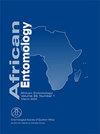黄柳叶不同提取物对家蝇的致死性和活力效率(直翅目:蝇科)
IF 1.2
4区 农林科学
Q3 ENTOMOLOGY
引用次数: 9
摘要
本研究以家蝇(Musca domestica)三龄幼虫为试材,测定了黄柳叶的石油醚、甲醇、氯仿和乙醇提取物的杀虫活性、生长调节、成体性能和驱避性。通过幼虫喂养应用不同的浓度,以进一步研究不同的生物学方面。数据显示,随着浓度的增加,三龄幼虫和蛹期的死亡率增加。与对照相比,幼虫和蛹的持续时间显著延长,呈浓度依赖性。此外,随着施用浓度的增加,化蛹率和成虫羽化率呈反比下降。LC50和LC90值可排列如下:石油醚(467.714和793.348 ppm)、甲醇(423.22和710.18 ppm)、氯仿(533.55和942.88 ppm)和乙醇(384.90和712.33 ppm),与作为阳性对照的合成杀虫剂溴氰菊酯相比,其LC50值为0.889 ppm,LC90值为1.367 ppm。总的来说,黄素福甲醇和乙醇提取物的毒性作用可以与作为天然杀虫剂的合成杀虫剂溴氰菊酯竞争。不同提取液对成虫寿命、成熟前期、成熟期和成熟后期均有延迟影响。测试的提取物表现出强大的排斥作用,在800ppm的浓度下,对石油醚达到约67.0%,对乙醇提取物达到87.3%。一般来说,黄樟叶提取物可以被认为是控制家蝇的有力候选物,并可以被用作综合病媒控制策略的一个组成部分,这可能有助于开发未来安全、廉价的天然来源杀虫剂。本文章由计算机程序翻译,如有差异,请以英文原文为准。
Lethality and Vitality Efficiency of Different Extracts of Salix safsaf Leaves against the House Fly, Musca domestica L. (Diptera: Muscidae)
In the current study, insecticidal activity, growth regulation, adult performance and repellency of petroleum ether, methanol, chloroform and ethanol extracts of Salix safsaf leaves were tested against third instar larvae of the housefly, Musca domestica. Different concentrations were applied through larval feeding to further investigate different biological aspects. Obtained data revealed that mortality percentages among the third instar larvae and pupal stage increased with increasing concentration. Moreover, larval and pupal duration was remarkably lengthened in a concentration-dependent manner vs the control. Furthermore, pupation and adult emergence percentages were inversely decreased with applied concentrations. The LC50 and LC90 values may be arranged as follows: petroleum ether (467.714 and 793.348 ppm), methanol (423.22 and 710.18 ppm), chloroform (533.55 and 942.88 ppm) and ethanol (384.90 and 712.33 ppm), respectively, compared with synthetic insecticide deltamethrin as a positive control that showed an LC50 value of 0.889 ppm and LC90 of 1.367 ppm. Overall, the toxic effects of methanol and ethanol extracts of S. safsaf could compete with the synthetic insecticide deltamethrin as a natural insecticide in the control. Different tested extracts affected the adult longevity, pre-maturation period, maturation period and post-maturation period in a delayed manner. Tested extracts exhibited potent repellency action that reached about 67.0 % for petroleum ether and 87.3 % for ethanol extract at a concentration of 800 ppm. Generally, S. safsaf leaf extracts may be considered as a potent candidate for housefly control and could be exploited as a component of integrated vector control strategies that may help in developing future safe and cheap insecticides of natural origin.
求助全文
通过发布文献求助,成功后即可免费获取论文全文。
去求助
来源期刊

African Entomology
生物-昆虫学
CiteScore
2.00
自引率
0.00%
发文量
17
审稿时长
6-12 weeks
期刊介绍:
African Entomology (ISSN 1021-3589 – print / 2224-8854 – online) replaced the old Journal of the Entomological Society of Southern Africa in 1993. A single volume consisting of two issues (March and September) is published annually. The journal is indexed in all major abstracting journals
African Entomology is a peer reviewed scientific journal that publishes original research articles and short communications on all aspects of entomology, with an emphasis on the advancement of entomology on the African continent.
 求助内容:
求助内容: 应助结果提醒方式:
应助结果提醒方式:


